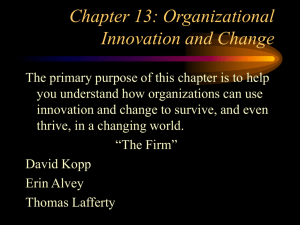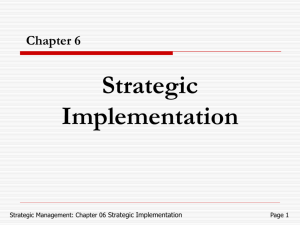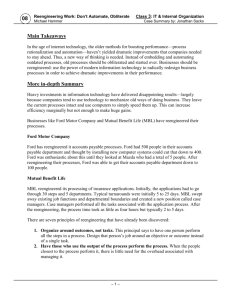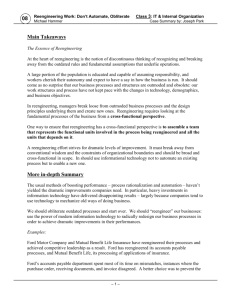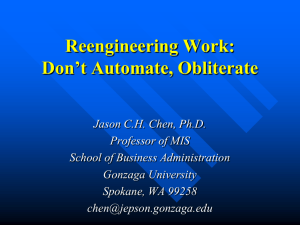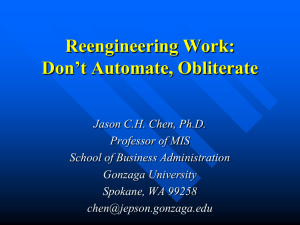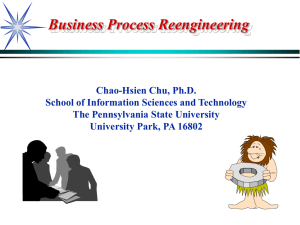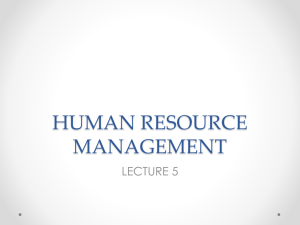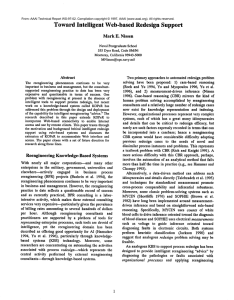Lighting the Way
advertisement
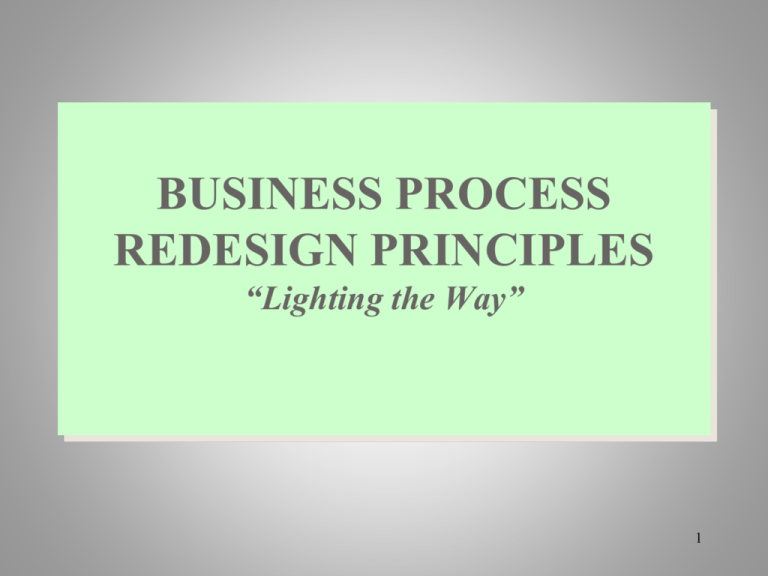
BUSINESS PROCESS REDESIGN PRINCIPLES “Lighting the Way” 1 Learning Objectives At the end of this unit, you will be able to: 1.0 List and describe the seven process principles for redesign. 2.0 List and explain the seven transformation principles to guide managers in their project strategy, structure and process. 3.0 Identify and describe the six principles that provide guidance for continued productivity and success (continuous process improvement). 2 SEVEN PROCESS REDESIGN PRINCIPLES 1.0 Organize Work Around Outcomes 2.0 Provide Direct Access to Customers 3.0 Harness Technology 4.0 Control Through Policies, Practices, and Feedback 5.0 Enable Interdependent and Simultaneous Work 6.0 Give Decision-making Power to Workers 7.0 Build in Feedback Channels 3 THE PRINCIPLES OF BUSINESS REENGINEERING (1) Process Redesign (2) Transformation Principles Principles (3) Continuous Process Improvement Principles Figure 2.1: The Principles of Business Reengineering (3 interlocking principles: process redesign, transformation and continuous process improvement) 4 Business Process Redesign Principles 3 questions to be answered when implementing reengineering change: 1. 2. 3. How do we develop effective reengineering designs? How can we ensure a successful implementation? How can we ensure continued application, productivity and effectiveness after the reengineering? These questions can be answered by 3 interlocking principles: process redesign, transformation and continuous process improvement. 5 The principles shown earlier is demonstrated in this insurance company claims-processing operation: 1. 2. 3. 4. 5. 6. 7. 8. 9. 10. 11. 12. 13. 14. 15. 16. 17. 18. 19. Claims were received and checked for completeness by one unit. On a daily basis, the unit supervisor would batch and summarize the verified claims before sending them to another unit for research. After research, the claims would be checked, summarized and forwarded to the approval unit. If any information was missing or new questions arose, the entire process had to be repeated. A customer trying to ascertain claim status would be told that it was “pending approval”. Processing took three to six weeks. A business reengineering project structured the verification, research and approval units into marketsegment customer-support units. Each unit was completely responsible for processing the customer claims assigned to it. All claims could be processed – there was no exception handling outside the units. Using a single-source computer database, the units scanned all claims and assigned them to representatives who had access to all information necessary to verify, research and approve a claim. When a customer called to check claim status, the information was immediately available to the claims representative or another unit member. Work could easily shift from one unit to another when emergencies arose. Standards and guidelines for payments were clear. New business policies and practices required limited supervisory involvement, review or approval. Work was delegated to supervisors by the work units as they deemed necessary. Processing time was reduced to 5 days. Unit performance (and the performance of each person within the unit) could be measured by the number of claims processed, the processing time per claim, and the costs associated with the claim. Customer satisfaction could now be related to a unit or an individual. 2 supervisory positions were eliminated and the same staff could handle 40% more volume. **All these values are illustrated in the 7 process redesign principles shown in the following slide. 6 1. Organize Work Around Outcomes • Enables people to measure the direct impact of their work on the organization. • It provides managers with the means to hold individuals and teams accountable. • It means business processes are grouped together to eliminate the need for “handoffs” and excessive checking. • Jobs become vertically loaded – people can act on information that they generate themselves. • It significantly reduces cycle times and improves responsiveness – two important goals for business reengineers. 7 2. Provide Direct Access to Customers • • • • • Work groups can be held accountable for their behavior. It allows for timely and accurate responses to customer inquiries. It eliminates the common mismatch between customer expectations and product/service development. People have the authority to establish and maintain customer relationships without intermediaries. Employees work cross-functionally and cross-organizationally with peer and up and down the hierarchy. 8 3. Harness Technology • • • • Technology can provide universal access to information. It allows people to act independently, bound by neither time nor place. Harnessing technology means providing access to the right information at the right time. Rapid technological changes mean business reengineers must be able to anticipate information need and answer the question: “Where does technology provide the most return on investment while still allowing flexibility for future changes.?” 9 4. Control Through Policies, Practices, and Feedback How do you maintain operational and financial control? • Institute clear, well-documented policies and practices on which to base decision making, followed by training in applying those policies and practices, and a solid feedback process that identifies errors and potential problems. • Feedback can take the form of periodic measurement or an audit process that randomly checks compliance with policy and practices. 10 5. Enable Interdependent and Simultaneous Work • • When people have access to information and can communicate cross-functionally and cross-organizationally, then work can be performed simultaneously (all together) instead of linearly. People can work in teams; teams are held accountable and rewarded for the final outcome. 11 6. Give Decision-making Power to Workers • • • Access to accurate information and a clear understanding of policies and practices empowers people to make informed, competent decisions. People can act quickly, responding to customer needs as they arise. The role of management shifts from supervisor to coach, from boss to facilitator, and from tactician to strategist. 12 7. Build in Feedback Channels • • • • How well are the BR project meet their goals? Measurement, assessment, and change capabilities must be added. Individuals and teams receive direct and immediate feedback from customers and others with whom they interact. The group can make immediate improvement. 13 SEVEN TRANSFORMATION PRINCIPLES 1. 2. 3. 4. 5. 6. 7. Assumptions and Biases Shape Behavior. People believe What You Do, Not What You Say. Involvement Breeds Acceptance. Just Don’t Do Something, Sit There. Change the Foundation First. Change Takes Time, but Not That Much. Progress is Not Linear, nor is it Smooth. 14 Assumptions and Biases Shape Behavior • • • Behavior cannot change until the underlying causes of behavior are addressed. Biases, beliefs, and assumptions determine an individual’s mental model and in turn, his or her behavior. Peter Senge states, “…new images fail to get put into practice because they conflict with deeply held internal images of how the world works, images that limit us to familiar ways of thinking and acting.” • Must change the way people think as much as it changes the way business operates. 15 People believe What You Do, Not What You Say. • • • Executive sponsors and project team members must demonstrate the behaviors that will be valued in the reengineered environment. Eg. Teamwork and Empowerment. There must also be consistent follow-through. Team members must be willing to speak the truth, challenge deceit (dishonesty), and act with integrity. 16 Involvement Breeds Acceptance • • • Old principle of selling, “people must own before they buy”. People won’t accept reengineering until they can see themselves living and working in the reengineered environment. Involve those most affected by the change in reengineering design and implementation – it delivers better, more easily implemented solution; it also minimizes resistance to change. OSM652/fy/November 2004 17 Just Don’t Do Something, Sit There Typical mistakes made by project teams and executives who act before they think: • Not thinking through the assumptions; • Not planning for every contingency; • Using coercion (force) rather eliciting buy-in. It creates project delays and unnecessary pressures. Bring in people from all affected departments to help think through their implementation before the team acts. 18 Change the Foundation First • The first phase of implementation is to create a foundation – that is, a common-knowledge base and view of the problem and its solution. • It is best achieved through introducing a common language and a set of business practices to support the language. 19 Change Takes Time, but Not That Much • • • • Transformation is a process, not a single event. Systems must be built, processes overhauled, reference materials developed, and people trained. Buy-in is best achieved through incremental implementation, allowing verification of benefits and refinement of the solution. From the beginning of a reengineering project, change should occur every six to nine months. 20 Progress is Not Linear, nor is it Smooth. • • • • Linear approach to transforming – is one in which each change follows logically upon its predecessor and each module of change is orderly and functions independently of other changes. Reengineering in an operating environment is a very disorderly process. The learning process generally results in negative progress toward the goal before a turnaround occurs and positive progress is made. The reasons for the BPR and its benefits must remain highly visible throughout the project. - Patience, timing, and persistence are critical to a successful transition 21 CONTINUOUS IMPROVEMENT PRINCIPLES • Reengineered business processes must be maintained. Six principles provide guidance for continued productivity and success. 1.0 Improvement is Everyone’s Responsibility 2.0 Improvement is Always Desirable 3.0 Pay Attention to Detail 4.0 Quality Requires Systemic (total/complete) Work 5.0 Create an Ongoing Exchange and Sharing of Information 6.0 Quality is Driven by Individuals, Not Organizations. The 6 principles outlined below provide guidance for continued productivity and success. Without continuous process improvement, the reengineering project team may win the battle but lose the war. 22 1. Improvement is Everyone’s Responsibility Each manager and each unit must be accountable for continuous improvement in these seven areas: • Communication • Quality • Error reduction • Productivity • Customer satisfaction • Cost reduction • Worker satisfaction and enjoyment. 23 2. Improvement is Always Desirable • • • A successful, healthy work unit, whether it consists of a large corporation or only two people, should constantly strive to improve what it does with the resources it has. Focusing on customers and improvements keeps the unit’s mode of operations proactive and anticipatory rather than reactive. People must be heard and given the power to implement improvements. 24 3. Pay Attention to Detail • • • • Improvements are lasting only when people attend to the lowest level of detail. Inattention to the lower level of detail can be disastrous. Work processes must provide detailed feedback data before the problems turns into a crisis. We should data to anticipate need, not react to a crisis. 25 4. Quality Requires Systemic Work • • • Improving the environment and customer responsiveness required a systemic (total) change – a change in the union contract and supporting business policy. People must have the skills to identify and analyze the problem, create problem-solving strategies, and communicate the situation to involve others. The organization environment must welcome and encourage such messages. 26 5. Create an Ongoing Exchange and Sharing of Information • • People can take action only if they have knowledge and awareness. A reengineered operations must include the following capabilities and values: - Methods for anticipating problems - Data is nonjudgmental and should be viewed as an opportunity for improvement Transmitting problem solutions and improvement ideas is a critical worker and managerial function. Information sharing should be proactive. People should be rewarded and encouraged to share information. 27 6. Quality is Driven by Individuals, Not Organizations. • • • • • Improvement happens because people care, because they are committed to the best performance and quality they can deliver. They believe they can improve. They want to improve themselves, improve the process, and discover and learn from any source possible. Peter Senge calls its “Personal Mastery” – continually striving to increase one’s contributions to the groups to which one belongs – at work, home, and play. Personal Mastery is only possible only in environment that encourages and rewards improvement at all levels. 28

